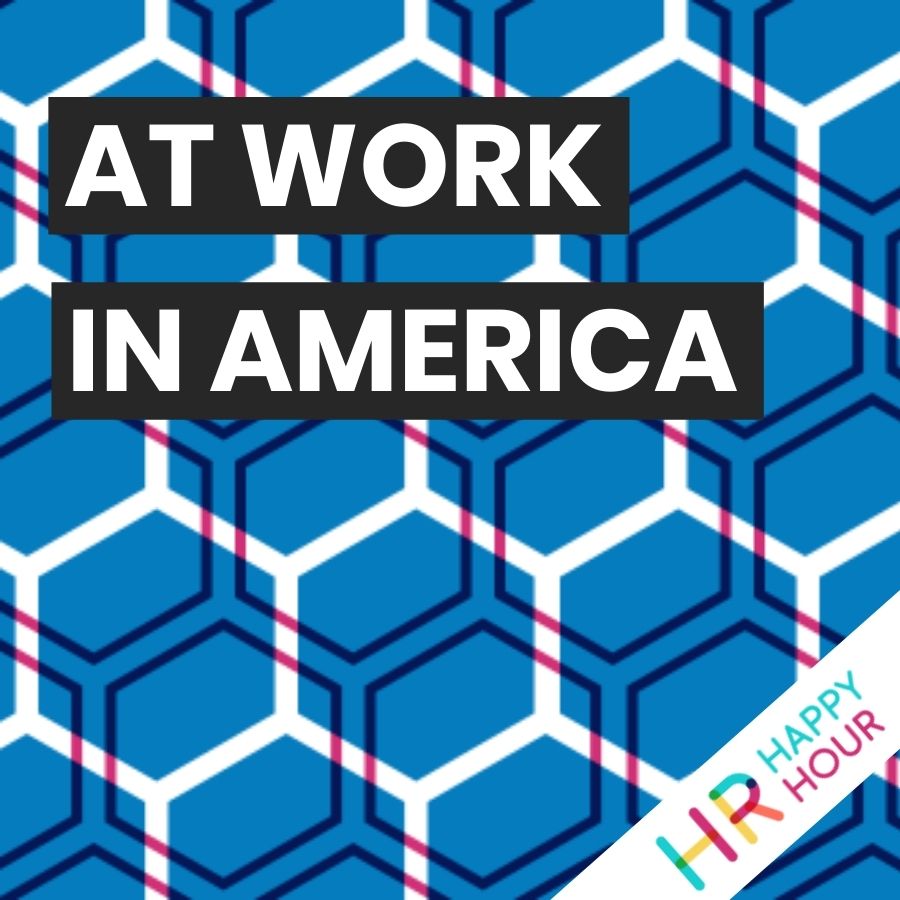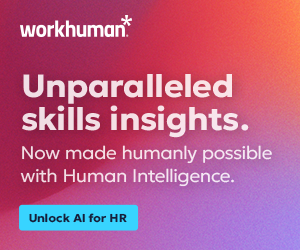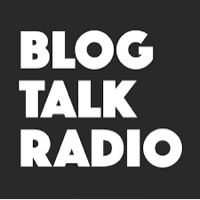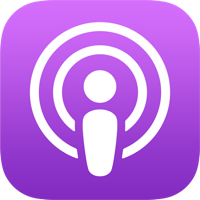Prep for Year-End and Start 2023 the Right Way – featuring Paychex
Hosted by

Steve Boese
Co-Founder and Chief Data Officer of H3 HR Advisors and Program Chair, HR Technology Conference

Trish Steed
Co- Founder and Chief Strategy Officer, H3 HR Advisors
About this episode
Prep for Year-End and Start 2023 the Right Way – featuring Paychex
Hosts: Steve Boese, Trish Steed
Guest: Tom Hammond, Vice President of Corporate Strategy and Product Management, Paychex
This episode of At Work in America is sponsored by Paychex, one of the leading providers of HR, payroll, retirement, and insurance solutions for businesses of all sizes. Even the most seasoned professional can easily be overwhelmed by the critical tasks that need to be done during year-end. Download the Paychex Year-End Checklist to get organized. In it you’ll find timely tips, important deadlines, and advice backed by decades of experience to help navigate this time of year, so you don’t lose momentum as you transition to 2023. Visit paychex.com/awia to download your copy, today.
This week, we met with Tom Hammond from Paychex, to talk about the importance of giving your business a year-end check-up to start your new year right.
– What to be thinking about as year-end approaches
– The importance of partnering with your finance team
– How to re-engage with your team to improve retention
– What you need to know when making wage changes in 2022
– Paychex year-end checklist: An important tool to have ready
Thank you for joining the show today! Remember to subscribe wherever you get your podcasts!
Transcript follows:
Announcer 0:25
Welcome to At Work in America sponsored by Paychex. We welcome a wide and exceptionally impressive array of guests, business leaders, HR leaders, academics, practitioners, consultants and authors to talk about the most timely, relevant and challenging issues that are influencing the workplace today. At Work in America digs in behind the headlines and trends to the stories of real people making a difference in the world of work. And now here are your hosts, Steve Boese and Trish Steed.
Steve 0:58
Welcome to the At Work in America show, we have a great show for you today. Trish, this is one of our favorite shows that we do each year. It is our end of year and beginning of the next year planning show all around payroll and HR and employee data. But actually more importantly, I think this year reengaging and reinvigorating kind of your relationship to your workforce for 2023. I’m excited Trish for today’s show. I know you are as well.
Trish 1:28
I am too. I mean, when you think back to those practitioner days for both of us, end of year is actually really stressful. And when you’re in human resources, you’re in payroll, you’re sort of running the people aspects of your business, you are always looking for those resources. And so I am proud that this is our third year that we were having our friend Tom from Paychex come back and actually help everyone with that end of year checklists, so it’ll be great.
Steve 1:54
Before we welcome Tom Hammond back to the show. Trish, I do want to thank our friends at Paychex. Of course, this episode of At Work in America is sponsored by Paychex one of the leading providers of HR, payroll, retirement and insurance solutions for businesses of all sizes. Even the most seasoned professionals can be easily overwhelmed by the critical tasks that need to be done during your end, which is one of the reasons why we do this show every year. But you can download the Paychex year end checklist to get organized, and that you’ll find timely tips, important deadlines and advice backed by decades of experience to help you navigate this time of year. So you don’t lose momentum as we transition to 2023. And you can visit paychex.com/awia to download your copy today. That link will be in the show notes. We’ll be talking about a lot of the information that’s in that year end planning guide. And of course we have well welcome Tom to the show to talk about it himself.
Steve 2:47
Back to the show, of course Tom Hammond. He’s the Vice President of Corporate Strategy and Product Management at Paychex, we are going to be talking about the importance of giving your business a year and checkup. With more than 30 years of experience at Paychex, Tom leads an organization that develops strong, intuitive and relevant human capital management solutions for America’s small and mid sized businesses. He also shapes and directs the execution of the company’s strategic vision that enables Paychex and its customers to succeed in an increasingly competitive market. In his role, Tom has been instrumental in delivering innovations that help entrepreneurs and HR leaders simplify the complexities of running a business by bringing to market powerful HR Payroll benefits and insurance solutions to more than 730,000 clients. That is the correct number. By the way. 730,000 clients which is unbelievable to me. Tom, welcome back to the show. Great to see you. How are you today?
Tom Hammond 3:42
I couldn’t be better. Steve, it’s great to be with you. And with Trish. This is clearly one of my favorite times of the year. It’s a really important topic. And I just love spending time with you guys. You you energize me in, in the mission that you bring to businesses across America. So love being with you guys.
Steve 4:01
That’s awesome. Great to see you. We read in the bio in the intro 730,000 clients I I feel like I want to go back a couple of years to the last couple times we did this show and it was probably 500,000 and then 600 and 500. Yeah, that’s exactly right. 730,000, which is kind of a testament to you and the team at Paychex and just the support. You’ve given so many small, medium sized businesses over the last few years. So it’s pretty remarkable. I love Well, I love seeing that success and growth and kudos to you and the team. Before we get into all the kind of year end stuff we want to talk about. Just congratulations, I guess I’d say you and the entire team there.
Tom Hammond 4:39
Thank you. Definitely a humbling figure to look at year over year over a year and the implication that that has on the United States of America so very much appreciate that great work from a great team very proud to represent them.
Steve 4:54
On let’s talk year end, let’s get into it. Now we we talked a little bit before the show there’s kind of four key elements are four key focus areas, if you will, that we’d like to talk about today for HR and payroll and business owners, quite frankly, as they get ready to end this year, and transition to the to the new year, we’re gonna talk about all four of them. First is kind of just getting your business data in order and in alignment, I’d love for you maybe Tom to share, I don’t know some of the key points here that organizations payroll, HR leaders, business leaders, etc. need to think about when it comes to getting your business data ready to go and up to date for year end?
Tom Hammond 5:32
Yeah, definitely. Steve, when we think of year end here at Paychex, and specifically the month of December, it’s just a perfect time for a checkup and starting with your business data is the foundation. So when we think of business data, it’s really about addresses of your businesses, the locations that you have a physical presence, your tax ID numbers, your tax rates, I want to spend just a second because there’s some new dynamics that we’re seeing in the market. Obviously, all of us are aware as HR professionals that the COVID pandemic introduce that remote or hybrid or flex work, however you want to describe it. But there was an I think, and a consequence that came with that remote work and some of the flexibility that businesses introduced. And what we’re seeing here at Paychex is that businesses have employees now who work remotely. And for businesses that don’t have a really tight process, what they’re finding is that those employees are moving to different GL geographies across the United States. And that’s introducing a very interesting dynamic where that business is now required to pay taxes in states where in the past, they didn’t have a physical presence. And that has caused a significant amount of consternation for businesses. So really important that you have and start with, where do you have employees that are physically residing, and now do you have the corresponding state tax IDs, state presence identified tax rates, etc, located in in loaded into your human capital management system, so that that’s a really important dynamic that we’re seeing here to take a look at as you end the year.
Tom Hammond 7:20
The second is about your payments. So are your payments up to date for your contractors, and for your employees. So this is a great calendar year from an HR perspective as the 30th of December is on a Friday. So with that said, you can actually make some decisions for your business and for your employees, do you want to pay your bonuses or your end of year? Payments? Do you want to pay him in 2022? Or do you want to move them to 2023 Certainly tax implications of those types of scenarios that you’d want to consult with your accountant or CPA on. But really great calendar to give you that flexibility. And then third, I want to say remember the Cares Act. So the Care Act Cares Act is coming up now on three years since it was passed. And that allowed a business to defer the payment of the employer Social Security withholding match of 6.2%. Businesses needed to pay about half of that, or 50% of that deferral by the end of last December, December of 21. And now the remaining 50% is due here by the end of December 22. My message here is a really simple one, make sure that that remaining 50% is paid by the end of the December, or you’re going to face a 10% penalty on the entire deferred amount. And that will increase to 15%. If the IRS issues a notice demanding payment and payment isn’t made within 10 days. So a really simple thing to forget. But if you do forget it, it will essentially wipe out the entire tax savings of what you gained through taking advantage of the Cares Act. So really important.
Trish 8:58
Yeah, I’m really glad you mentioned that one specifically time because I mean, personally, I had sort of forgotten about that penalty part, the 10%. So and I think too, it’s as you’re sort of talking through these, I’m just picturing in my head again, being in that HR role. It’s like, this is such a good way to partner, like you mentioned with your accountant, or your accounting and finance team, if they’re internal, depending on the size of your business. It really gives you insight into how the how the business both makes and saves money, which I know is sometimes something that HR kind of gets dinged for right, that we’re not as financially savvy maybe about the business holistically. So I think what you’re you’re sort of laying in our hands is a way for those HR leaders and those payroll leaders to sort of be proactive, even if the accountants have it all figured out. Right? Just the fact that you’re going to have that conversation with them. Great way to to show your onboard you support that and maybe, maybe in fact, you will sort of sort of surface something that they’ve forgotten about. So really great.
Tom Hammond 9:59
No doubt about it. No doubt about attrition and partnering with a partner like Paychex, we’re constantly trying to communicate the implications of legislation whether the legislation was passed last week, six months ago, or in this case, almost three full years ago. And what an impact that could have if you just forget that. Certainly it would be a detriment to any business of any size.
Steve 10:24
Yeah, Trish said you’d forgotten about some of the penalty provisions in the cares. When it comes to remittances. And I thought to myself, I forgot all about the Cares Act, I’ll be totally honest with you. It’s cuz, right, it feels like it was. This has probably been the longest three years of our lives, right. So 2020, feels like 20 years ago versus three years ago. But it is important to remember that some of those regulations and provisions that were passed back then still have repercussions today. And it’s much like we’ve sort of forgotten about some of this, it’s super easy, not just maybe you wouldn’t forget about it if you were responsible for doing this. But just going back and doing the appropriate record keeping and making sure you’re doing this correctly, that’s certainly not easy, right? Especially when you’re trying to try to run your small business or medium sized business at the same time.
Trish 11:16
I think to when Tom talked about, you know, just you might have, look, you might not have had something in place to sort of make approvals on where people were working from which states and now all of a sudden, you’re having to play catch up there, too. Again, that was something obviously, not through pandemic, but I was losing sleep over that having employees and I think it was, you know, 43 states at that time, just trying to be a midsize business and keeping track of all of that, and all of the legislation changes at a state level as well. Overwhelming. So I think time the fact that you’re saying like, we’re going to stay on top of that for you, and we’re going to make sure we’re reinforcing you. Right, so that you can look smart. And, and stay on top of it and and make all of the necessary filings or changes or, or whatever needs to be done.
Steve 12:07
It’s really tricky. I just saw a piece the other day I forget, I forget the country, it was a little bit similar kind of issue involved a different country, but it was a small business. And they had gone fully remote and had remained fully remote throughout all of this. And they had a couple of employees who decided one went to go live in Spain, and the other went to live in I don’t know, England or something. And the US company wasn’t really authorized to employ people in either of those places. And was going to run into trouble, right? Because right now and so I certainly, yeah, there’s that as a slap in the year and maybe even time to just send out a message to the to all employees and say, Hey, here’s what we have for you, right? Individual messages. But like here, here’s what we have on file for you verify this is correct, even right, just take that stuff.
Tom Hammond 12:54
And I think Steve, that’s a perfect segue into into the second set of data that really needs to be confirmed. And that’s going to now the employee level. So we’ve already spent a few minutes talking about, hey, the address of that employee is going to drive your State Taxation and may drive minimum wage rules, different HR provisions that need to be communicated to the employees where they live. So really, that has become bedrock as well, that’s very foundational. If it’s not accurate, that can have a sweeping impact. And you’ll soon find as the HR practitioner responsible for payroll, that you’re going to be spending an awful lot of time with the IRS, whether it’s at the federal level, or the state level, government agencies trying to figure that out. So obviously, one of the the real keys there is making sure that that employee demographic data is 100% accurate. But in today’s world, that should not be a task that an HR professional is trying to pull off paper reports and make phone calls to employees to handle that with the mobile technologies that we have here at Paychex and the other strong HR providers have available to them. That’s about creating a mobile culture, and Employee Self Service culture, which is really, really important to drive the efficiency and effectiveness of the HR organization.
Tom Hammond 14:14
So my recommendation would be leverage that mobile application and give that to the employees to validate for you for the state taxes, make sure you’re registered, make sure that withholding is up to date, the IDs are all their employees who are working in moving all around that just introduces some new challenges. And then I would go to some real specifics. So third party sick pay. So for HR professionals that’s make sure that data is entered into your into your payroll and HR system so that the withholdings for the employees that are being paid by an insurance provider are applicable in on that employee w two. If not, you’re going to have to go back and do amended returns which is a complete mess and a challenge for any size business. And then lastly, remember those kind of abstract benefits like Group Term Life Insurance and personal use of a company car, if applicable, make sure that those are entered appropriately. So they hit the W2, and the taxation is appropriately taken care of. And then any manual checks that didn’t quite make it into payroll before the end of the year, make sure those are there. So you’ve got an accurate w two. But the foundation here from an employee perspective is, hey, as an employee, I think we all expect to take responsibility for our demographic data, give us the opportunity to do that. Don’t make that a headache that you need to take on from an HR perspective, just provide the mechanism, make sure they’re enrolling in the mobile applications that are available. Just to give you an idea, we’ve got over four and a half million individuals leveraging our mobile application across the United States. So it’s very simple to just send a note, if they don’t have it, your provider should be able to give you the appropriate communication to say downloaded here, here’s how you get your employee ID set up. And within a few minutes, you should be up and ready to go. And that should be a real simple way to drive efficiency for you.
Trish 16:07
That’s a great tip. You know, it’s funny, Steve and I were just talking the other day about, especially those businesses with a high percentage of deskless. Workers, right? Yes, they may never have a computer to go to. So you’re right. I think if you just start that where you’re absolutely going to send it through on a mobile device. For all employees, it gets everyone in the habit. Hopefully, they’re already in the habit. You know, I think just a few short years back, they weren’t. And so I know when we were at HR tech this year, you were you and the team are showing me your mobile app. And it really does so much. So this is just one sort of little sliver of what you can achieve in in overall communications, which not only makes it easier for HR and payroll, but makes it easier for the employee as well, they don’t have to go necessarily find a computer login, you know, try and figure out what’s going on right there on their hand, right?
Tom Hammond 16:56
If we go and just use Paychex as a as a litmus test, in our last fiscal year, we had two, almost 2 million individuals who, digitally on boarded via a mobile device. So just think about the power that that has for a any size business. But think about the impact that has on HR, where the demographic data is entered by the employee, ie the that includes where they’re residing to ensure that you’ve got the right state withholding right from the start, and the ability up to and including the enrollment in your retirement plan, your insurance plans, etc. Imagine the productivity that comes from not having that be a paper based process. And more than anything, you’ve established a strong foundation with that employee, that you are a fortune 500, like fortune 100 Like organization with a digital onboarding experience, and that we’re really focused on how you get to work and start running at what we hired you for, we’re not interested in creating a full day or referral for a full few days, when you get started to just get your paperwork up and rolling. So it really has a morale and engagement, efficiency opportunity inside of it as well.
Steve 18:10
Yeah, and the thing that’s remarkable about the last, I don’t know, call it 15 years or so of the growth of these technologies, that these kinds of technologies, these fortune 100, like level technologies, they’re now available to organizations of all sizes, there’s really no organization too small, honestly, to avail themselves of these technologies. Because they’re accessible, they’re easy to implement, they’re affordable, they’re easy, they’re intuitive, employees can adopt them really on their own without really great having to be trained right one on one, it’s remarkable how far the technology has come and democratize access to really powerful solutions to organizations of all sizes, which is fantastic. That to me, was the greatest promise, if you will of cloud based technologies for HCM. And that’s what we’ve seen. For sure. So, Tom, I think we’ve talked a lot about business data and employee data. Maybe that’s segue a little bit to some of the other opportunities, if you will, for organizations and for HR and business leaders at year end, specifically around real challenges around retention and re engaging employees at this time of year. I’d love some thoughts from you on know, what are some of the things that employers or HR leaders can do to kind of re engage with their teams and think about retention as we move into the new year?
Tom Hammond 19:32
Yeah. Yeah, that’s a great point, Steve. So leveraging benefits as a retention tool in December to me is a critical opportunity to re recruit your entire organization, or at the very least re recruit your top talent. Our data is showing that many businesses are still struggling to find people to just fill open positions and to retain their existing employees. Now certainly, we’ve got outliers here we’re with some of the big tech giants have Have done layoffs. But the vast majority of the customers that we’re interacting with are really struggling still with, Hey, I’ve got open positions, and I’ve got to retain my people. So that’s a really tremendous opportunity to leverage your benefits package to re recruit those great employees that you already have recognizing it’s going to cost you 10s of 1000s of people or dollars, excuse me to re recruit with a new individual, and then get them trained and up and rolling. So Benefits Open Enrollment obviously is heavily skewed to calendar your plan. So open enrollment could be running in your organization through the end of December, make sure you’re communicating the benefits you’re offering. Most employees have no idea of the full suite of benefits that are available to them. So leverage that open enrollment as a real marketing opportunities to educate your employee and the investment that you’re making in them. I like to tell people to consider a total rewards statement, a total rewards statement is a really powerful marketing tool. It’s a simple statement that shows your compensation, your benefits the employer match of your retirement or your insurance deductions, it can include the cost of training that you’ve actually incurred on behalf of an employee.
Tom Hammond 21:18
There’s lots of ways that individual small costs add up to a significant reward for an employee, I would encourage you to speak to your your HR provider, if they don’t have a total reward statement, give us a call, I’d love to have an opportunity to talk with you guys about that it’s a powerful tool that most don’t take advantage of. Next, make sure that your employees are really fully aware of what benefits will expire. It’s incredibly frustrating to HR professionals, when an employee comes in and says, Hey, you never told me my dependent care FSA, or my medical FSA dollar amounts, and now they’re gone. What about calendar year paid time off if you have a policy where you use it or lose it, that is a horrible experience and a way to completely deflate morale, if you don’t communicate those things on the flip, it is a great way to engage your employees and really give them access to what they’ve worked hard to have the opportunity to take advantage of make sure you’re 23, your 2023 benefits data, make sure that’s updated for your first payroll in 2023. Otherwise, you’re going to have a lot of cleanup to do right from the start. And then my last piece would be technology has significantly changed when it comes to W twos and the industry for 30 years. That’s a massive enhancement that I have seen. Just to give you a sense of of what it looks like here at paychecks, we’re communicating to our clients that their employees will be able to access their W2 on January 6. So I want to think about that January 6, employees are going to be able to go to their flex mobile app and download print, move to their appropriate tax provider, their individual W2. And there are millions of individuals across the US that don’t need to wait for anything else other than that W2, and they’re really interested in getting their taxes filed because they’re expecting a refund, that’s a great opportunity to actually get the employee into the mobile tech, and to to change the paradigm where they’re interacting with the mobile app, you can give them their check stubs, then you can give them access to the demographic data and try to, to change this from a year and checkup to a constantly new process. So there’s a lot here from a retention perspective and a recruiting perspective, just take advantage of all that you’re doing. And use that total rewards concept as a way to re recruit your existing staff.
Trish 23:53
What I love about all of that time is that for the longest time, I think I was on the soapbox of benefits can be strategic. And that’s just one small way that you’re you’re giving an example of how benefits can be really strategic for the organization. I think that you know, I’ve certainly worked in places where you are trying to just maybe do a passive enrollment, you really just want people to just kind of slide under the radar. Right. And it’s such a bad approach like, this is your opportunity, right? I love that you’re saying sort of, you know, get them involved, again, really show them what benefits, they have helped them with things, they might be losing all of those things. You’re right, it’s gonna save you time and money in the end, because you’re not out there recruiting people.
Tom Hammond 24:38
So yeah, think about your long if you’re a long standing employee in an organization, the last time you probably had a detailed benefit walkthrough may have been when you were on boarded. Right. And is that the way it should be? I don’t think so. I think those are the folks that you would want to really understand you know, all the benefits that you have available to you and what the impact those could be. That’s really what we recommend best practice.
Trish 25:02
I think, too, when you talk about total reward statements, it was not that long ago. And I’m sure there are still listeners out there who are doing it with, you know, Word documents and mail merging to the addresses and trying to to create this on your own. I’ve been that person. It’s a noble effort. But my goodness, it’s like, don’t
Steve 25:21
don’t even get started on the security implications of doing that kind of thing. Oh, things like Word and emails. It’s all.
Trish 25:29
Yeah, we’ll save it for Halloween. I’ve literally worked somewhere where it got off by one by one row. For like, hundreds of employees. I didn’t do it. I’m just gonna say that right now. But yeah, so a simple tiny mistake can really just cause total chaos. So I love this idea, having it mobile, making that available. So it’s all accurate. It’s all on time. And it’s a recruiting and retention tool. So all the better.
Steve 25:57
Yeah, for sure. And I echo a lot of your statements, Tom about how Yeah, sure. We read the headlines. This is a little bit of a go on my soapbox, too on this, we read the headlines about tech company A or company B, maybe doing some layoffs. And that’s certainly been happening over the last few months. And it’s really sad. And I feel for everybody who’s impacted by this. But on the on the flip side, right? Think about just not living our lives. I feel like everywhere I’ve gone in the last three, four months, every airplane, every hotel, every restaurant, every ballgame, you name it, right? They’re full of people. They’re packed. I went to I went to Epcot for a day, not too long ago, and about a month, it was the most crowded I’d ever seen it like I mean, literally people were bursting from the seams of of, of Epcot down in Disney World, right. So maybe there things are slowing down in certain parts of the of the market at certain parts of the economy. And some firms certainly have let people go. But on the macro level, and certainly in many of the small to mid sized businesses, the service oriented businesses, the hospitality and leisure businesses, I don’t see it personally, just from, you know, living life, I think organizations are still really, really struggling with retention and hiring. So yeah, to any opportunity to strengthen your relationship with your, with your team, and your team members at the end of the year is a great, great idea. Going into 2023. Thank you.
Trish 27:22
I have a quick question for you on mobile adoption of these, I’d love to just get a little perspective on that. Because I will admit raising my hand I, I will use mobile tools now. But my inclination is to always go to my computer, I don’t know if I’m just, you know, it’s tiny. It’s in my hand, I’m trying to figure it out. While my kids, for example, who are 19, they do everything for college, on their phone, right? They they registered for college, they got all their classes, they did all their financial aid. Can you talk a little bit about like, from your customers, you have so many customers? What’s kind of the, the feeling and just around mobile usage? And how are they adapting?
Tom Hammond 28:03
Yeah, we actually see utilization at both the desktop, and the mobile phone. So desktop, tablet, and mobile phone device. And it’s really interesting when you start to dissect that we have tons of examples, in fact, hundreds of 1000s of examples every week, where the payroll process actually started in the office on a desktop, we can see it transfer to a tablet, and we can see it finish on a phone. And it is really fascinating. We can also see that it’s happening in three different locations. So it’s really a proof point for us that the world is mobile. And the expectation is you need tools that can bridge the gap to fill fit the needs of each of us as consumers of technology. So it’s very fascinating to see, there are weeks where we see 50% of the transactions on a phone 50% On a desktop. And across our time and attendance solution set we see it very much diverse from diverge, I should say from some folks using a watch some folks using an actual kiosk, some using the phone. So it’s a fascinating set of data to watch. It actually creates an incredible opportunity for us. But it also is a big challenge because now you’re trying to ensure that your user experience actually can roll between those different types of medium. So it’s a fascinating activity to watch.
Trish 29:40
Yeah, thanks for sharing that I can tell you as someone who was a tiny bit reluctant when we were at HR tech, and you showed me the payroll approval on the phone, and I’m just like picturing in my head that would have saved me from being away from my family and my children for hours and hours that I used to sit at a desk somewhere and approve it manually. So yeah, I think that might be the tipping point for me. So yeah, you guys are doing good work there.
Steve 30:06
Thank you. Absolutely. A couple of last things, Tom. And then I want to I want to sort of close with something I just learned this morning about some 2022 data that I have. I saw this in the notes Tom, I was shocked by this is someone who follows labor market and the news and I love this stuff. I was shocked by this stat. According to my notes, there’s 21 states and 39 localities that are making changes to minimum wages effective. I’m shocked by that number. Right, Tom? What do folks need to do this sort of be ready for that?
Tom Hammond 30:38
Well, first and foremost, make sure that that first check date is lined up. But there’s really a handful of strategies you need to be thinking about. So in those 21 states and 39 localities, make sure that you’ve adjusted the the wage amounts on those particular employees. But what does that do from wage compression? Does it introduce wage compression? Now? What’s the impact on your budget? Is your finance organization linked with HR? Do they truly understand, hey, we’ve got a built in increased budget here, just based on something that we had no control over. So that would be the first thing, Stephen, kind of right on the coattails of that are many businesses do their full wage adjustments for the new year, make sure that that’s in place for that first payroll, and again, opened up really common? Yeah, exactly. Open Enrollment. Traditionally, most businesses make that a calendar year January start. So if you’re not leveraging an admin platform, that could be a set of work that you have to manage yourself. Certainly, with leading providers like us, we have a concept of effective dating that allows you to say, here’s $1 amount, this is for everything in 22. Here’s the dollar amount, this is for everything, and 23. Make sure you’re leveraging that and reaching out to your partner, if it’s not us to say Hey, can I take advantage of that, and then those policies. So there’s an awful lot that we’ve talked about today, that is policy driven. So if you’re starting or introducing new policies, or if you want to clean up a problem that you had in 2022, that we just discussed, now’s the time to say, Okay, I’m gonna update my employee handbook and, and make sure all of the employees understand the implications of any changes that we’re going to assume on one one of 23. All of that’s really to start the year on the right foot.
Steve 32:26
Tom, that’s an awesome rundown of some of the things you need to know. And again, we’ve talked, we’ve talked about this, as well as in years past, the importance of working with a provider like Paychex, they’re going to be doing a lot of this work for you, right, or at least in support of you. Right. So when the state of Rhode Island changes the minimum wage effective one 120 23, and you have employees in Rhode Island, like you’re going to be sad, or taxation rates changes, we didn’t get into that, that changes probably quarterly right around the country. And yes, in literally 1000s of withholding districts right around around the around the country. Staying on top of that’s impossible, right yourself, right? Especially if you have a dispersed employee base, you’ve got to have the right partner to help you do that stuff. And it’s so you can focus on the things that really matter, right? engaging those employees and talking to them and coaching them and communicating with them and making sure that they understand, right, all the all the benefits that are available to them and some of the things we talked about.
Tom Hammond 33:24
I guess, you use the right, you use the right term, and it was you need the right partner. So the question we always have is, do you feel like you have a partner? Or do you have a provider, because they’re very different. A partner is going to be on top of that communicating with you and making sure you’re you’re set and ready to roll with all the proactive items that we talked about today. A provider is going to say, hey, we communicated that to you in some way, shape, or form. That’s, that’s up to you. So definitely the partner is the key.
Steve 33:53
Yeah, that’s great, great stuff. I want to just remind folks again, that the urine checklist a Paychex provides and by the way, you don’t have to be a Paychex client to get to this resource. Paychex does this for everyone for the entire community, which is much like they do all year long. And through COVID Especially, we don’t have to revisit all the things you did for the community and for your customers through COVID which was quite frankly remarkable. I don’t know what the number was was like millions and millions of dollars, you helped employee employers recover and keep people only payrolls. Yeah, it was ridiculous. It’d be it’d be okay. I knew was a big number. I didn’t want to guess billion but so you go to paychex.com/awia to download the urine checklist today. We’ll put that link in the show notes once again and we’ll be sharing that periodically as The show runs and throughout the rest of the year. And I do want to thank Tom again before Tom I let you go I wanted to just mention this because you don’t know this either because I just worked on this this morning. We’re prepping for your end as well. You’re at H3 HR Advisors, prepping like some year end newsletter stuff that we send out to to our for our friends and I was looking at through some of our the things on our site and the things on the where we post all these shows. And the posts that we did in the video are on the Paychex voice assist technology that we recorded at HR tech, Tom remarked did remarkably well, it was like the second most popular post we had all year on our site. And then I want to shout out our friend Allison Stevens from paychecks, who came on the podcast to do a little preview of some HR tech conference stuff. And we did a preview show was the the second most popular post on the on the, on our HR happier.net. site for the entire year round two.
Trish 35:41
I feel like you need an award. You know, Tom, in honor of that, we’re going to send you the golden cup of you know.
Tom Hammond 35:49
I will be waiting for it. I can tell you that. Allison is an incredible resource. And I’ll sincerity she is a great HR professional and practitioner. She is a sharp, sharp resource. And one of the reasons why our HR Solutions continuum is so successful, she runs a really great organization, and they provide an amazing benefit to our clients.
Steve 36:11
Yeah, really, really underrated sort of set of services that paychecks can provide to their clients that is distinctive in the industry, too. And well, we’ll get some links out there as we get to our year end summaries of our years. Well, those great resources throughout the year. So Tom Hammond, great to see you once again. Thanks for joining us for the third annual year and prep year forward launch show and I hope all as well and you and all our friends at Paychex have a great end of the year and great holiday season.
Tom Hammond 36:44
Thanks Steve. And thank you Trish. It’s great to be a part of the show. Thanks for the opportunity and Happy Holidays to you and all of the listeners. Thank you very much.
Steve 36:54
Great stuff, Tom. Thanks again Trish great stuff as well. We’d love sitting down with Tom. He’s one of our very, very best friends in the industry and good good stuff. So we will link to all the things we mentioned in the show notes. And yeah, get ready for your end. You’ve got a couple more weeks to go but you’ll get there and our friends at Paychex are there to help you. All right. For Trish Steed, for Tom Hammond, my name is Steve Boese, thank you so much for listening, the HR Happy Hour Show. We’ll see you next time and bye for now.
Transcribed by https://otter.ai
Talk to us
If you want to know more about any aspect of HR Happy Hour Media Network, or if you want to find out more about a show topic, then get in touch.









